Pyrrhic victory of the German army
Preparation of the operation
In the winter of 1917 - 1918 There was an intensive preparation of the German army for the offensive. Based on a summary of combat experience 1916 - 1917. 26 January 1918 was issued the instruction "Offensive positional war." It was supplemented by a number of other instructions and instructions that determined the actions of various types of troops and their interaction. The main provisions of the instructions boiled down to a long-cherished idea — to break through the enemy’s defense system on a broad front in order to move from a positional war to a maneuver one. The breakthroughs were planned to be accomplished by concentrating powerful forces and means on a wide front and to achieve methodical preparation, surprise, speed, force of strikes and a great depth of penetration into the enemy defenses. Suddenness is provided by the secrecy of the entire training and short (2-4 hours) artillery preparation, based on the refusal to destroy the enemy fortifications and to neutralize his infantry and artillery by mass use of chemical projectiles. The strength of the first strike, supported by the support of a powerful mass of artillery (up to 100 guns on 1 km of front) and mortars, should stun and demoralize the enemy.
The offensive, especially in the second period of the battle, assumed the provision of a broad initiative to commanders. In case of a breakthrough in order to maintain the pace of the offensive, it was recommended to avoid frontal attacks of resistance centers, and to bypass them from the flanks and rear. Ahead followed assault troops and sappers. The divisions of the first echelon were instructed to conduct an offensive battle until the exhaustion of their forces was complete (previously the divisions were replaced, relegated to the rear until the exhaustion of forces). The implementation of this principle led during the offensive to great losses and the loss by many divisions of combat capability.
Particular attention in preparing for the attack was paid to the improvement of artillery tactics. 24 January 1918, the directive of the High Command introduced a method of refined shooting of Captain Pulkovsky, which was reduced to the suppression of enemy artillery and infantry by sudden fire without prior adjustment. At the same time, a system for organizing the centralized control of artillery masses, developed by Colonel Bruchmüller, was introduced. The artillery was to suppress the enemy’s defenses to the entire tactical depth, to neutralize his fire weapons, the work of the headquarters, command posts, communication lines, front-line railways and highways. The effectiveness of firing to defeat increased mass application of chemical shells. To accomplish this task, according to the Bruchmüller system, all artillery was divided into four groups: 1) combat groups with infantry were created in the sector of each division of the first echelon. They included light artillery and mortars; 2) anti-artillery groups were organized in sections of army corps and divided into subgroups according to the number of first-tier divisions; 3) long-range and flanking heavy artillery groups were created at the sites of the army corps and were intended to bombard camps, command posts, communications centers, roads, and flanking enemy positions; 4) on the front of each army were organized heavy groups of flat fire, intended to fire the most distant targets. With the beginning of the attack of the infantry, a barrage of fire was set up, which was to paralyze the enemy, drive him to shelter and allow his infantry to catch the enemy in his fortifications.
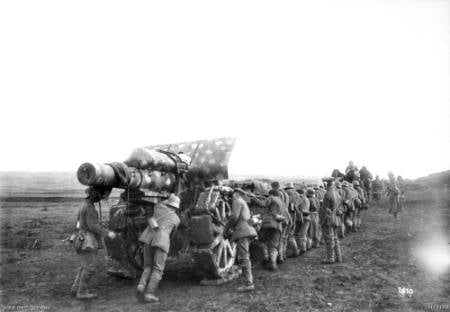
Since the beginning of 1918, all divisions intended for the offensive were withdrawn to the rear and underwent three-week training in accordance with new instructions. The main task was to develop ways of moving behind the fire shaft, overcoming obstacles on the battlefield, as well as methods of dealing with tanks adversary interacting with aviation, infantry escort artillery, engineering troops and communications units.
By the 21 of March, the German divisions were concentrated on the offensive front from Krausil to La-Fere in 70 km. Three armies on the front of their location in 62 km were 106 guns of various calibers (about 6824 guns were stationed on the 70-kilometer front of direct attack) and around 6000 aircraft. Troops were built in three echelons. In the first echelon of the operational formation there were 1000 divisions, in the second - 30, in the third - 19 and in reserve - 10 divisions.
On the 70-km front, chosen by the German command to attack, the 3-th and 5-th English armies defended, having 32 infantry and 3 cavalry divisions, 216 tanks, around 3000 guns and around 500 airplanes. Thus, on the breakthrough site, the German command managed to create an approximately twofold superiority in forces and assets over the enemy.
March 20 artillery and mortar batteries of the Germans took up positions on the front line. In order for everyone to have enough space, they had to be placed in three rows - behind the trenches, on the line of fortifications, and slightly ahead. The infantry units were placed in tight rows on the front lines and disguised from enemy air surveillance. The British and French pilots really did not notice the activity of the Germans either on the front lines or on the front-line roads. General Ludendorff proudly recalled: "The enemy until the last moment remained completely ignorant, otherwise he would have taken more effective defensive measures and would have pulled reserves closer to the front line."
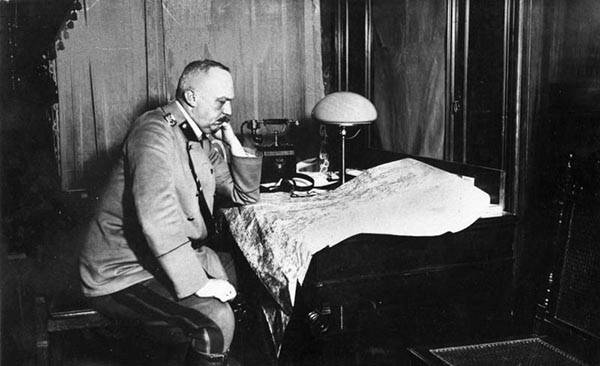
Erich Friedrich Wilhelm Ludendorff
Beginning of the offensive
21 March 1918, early in the morning, German artillery opened fire on British army positions from Krausil to La Fere. Artillery preparation lasted five hours. During the first two hours, the artillery positions of the 3 and 5 British armies were subjected to especially heavy shelling. The Germans actively used blasting and chemical projectiles. Intensively fired headquarters, command posts, the location of the troops and rear communications of the British armies. Then the fire of artillery batteries, reinforced with mortars, was moved to the defensive positions of the British infantry. Losses of the British were very serious. The first line of defense was devastated. Radio and telephone connection was broken.
In 9 hours 40 minutes, the German infantry went on the attack under the cover of the firing shaft. It was followed by anti-aircraft artillery for cover from enemy aircraft and tethered aerostats to monitor the progress of the battle and adjust artillery fire. At the same time, part of the German batteries continued to fire at enemy strongholds and artillery positions located in the second position. The response fire of the British, paralyzed by the suddenly started artillery preparation and thick fog, was ineffective. However, during the offensive, the interaction of the German infantry with artillery was disrupted due to thick fog. The rampart went far ahead, and the infantry lost contact with it. Many pockets of resistance were not suppressed by artillery, and the infantry had to spend a lot of time and effort on their assault. German aviation dominated the air. In 15 hours, attack aircraft entered the battle, which, before dark, struck the centers of resistance of the Allies. As a result, German aviation provided strong support to the advancing infantry. The British aviation, due to the twofold superiority of the German one, did not show activity.
On the same day, March 21 in the area of the city of Saint-Quentin, the Germans for the first time used their own tanks in battle. It was a heavy car - A7V, rather ridiculous looking, similar to a railway carriage set up on tracks. The first German tanks had a mass of flaws (like English ones) - they had a great height (more than 3 m) and a low speed, representing a good target for artillery, also had very low maneuverability and stability. However, they made an equally intimidating impression on the English soldiers than the British themselves had done in their time on the Germans, and reinforced the fighting spirit of their infantry.
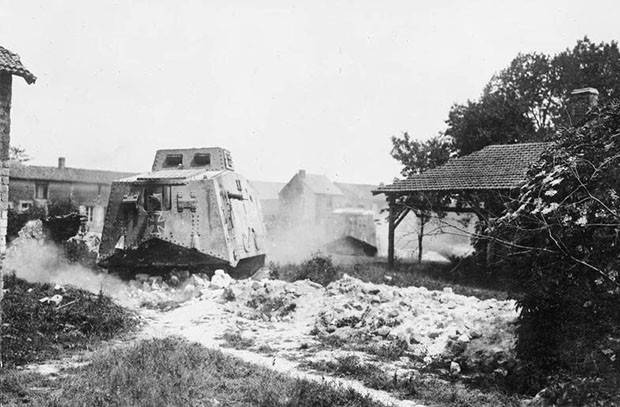
German tanks A7V
By the end of the first day of the 17-th and 2-th Germanic armies penetrated into the British defense at 2-4 km, the depth of the 18-th army was 6 - 7 km. Thus, the task of the first day of the offensive - a tactical breakthrough and the seizure of enemy artillery - was not completed. The Germans managed to capture all the 138 English guns. Good rear communications allowed the British to delay almost all artillery to the second position. In addition, the 17 and 2 armies also failed to reach the enemy in the ledge from Cambrai, which Ludendorff considered a necessary prerequisite for the success of the entire operation.
Over the next two days, the onset of the 17 of the German Army, encountering strong and well-organized resistance from the 3 of the British Army, developed slowly. By the end of 23 March, she had advanced with great difficulty just 5 - 6 km. The troops of the 2 of the German army advanced much faster. On the night of March 22, the commander of the British army 3, fearing the coverage of his troops in the ledge at Cambrai, took them back to 2-3 km. As a result, by the end of the third day, the 2 Army was able to overcome the tactical British defense zone and advance 10-12 km. The offensive in the sector of the 18 Army was developing at the highest rates, although it was to perform an auxiliary task in accordance with the plan of the operation. For three days, the 18 Army went deep into the enemy’s position on the 20 km, completely broke through the tactical defense zone of the British Army 5, and forcing the r. The Somme and the Crozat Channel, began fighting to overcome operational defenses.
A major role in the success of the 18 Army was played by aviation, which was sent to those sectors where the strongest battles were fought. Thus, the 22 of March, the resistance of the 50 and 61 of the British divisions in the Bovois region was broken with the help of the 30 attack aircraft, from the height of 50 and firing at the enemy. The next day, German assault squadrons made raids on the reserves suitable for the 5 of the British army, on the withdrawing troops and transports. However, by March 23 the situation in the air began to change. On this day, the battle entered the French aircraft. Activated and British aircraft.
Thus, in the early days, the allies seemed to be repeating the 1914 nightmare of the year. Terrible German divisions rushed to the assault on the allied positions. 174 thousand British were killed and wounded, tens of thousands were captured. The German army rushed to Amiens and threatened to cut off the northern flank of the allied front. Historian Basil Liddell Garth described the events of those days as follows: “In these weeks, Germany was desperately close to returning the brilliant chance of victory that it had lost, which she missed in early September of 1914.”
The Russian military historian, General Andrei Zayonchkovsky, wrote: “The Germans, having advanced their center and left wing by another 15 km, reached the positions they were occupied with before their departure in the 1917 year, and the English army was completely disheveled. The British began to depart to the north-west to the sea, and the French to the south-west, having the task of covering up Paris. It seemed that the Germans were achieving their goal. "
As a result of the 21 - 23 March battles, the 5-I British army was so exhausted that it could no longer hold the front on its own. Her position aroused the apprehensions of the British command. In the first days of the "spring offensive" of the German army, the absence of a single command and all-Union reserves of the armed forces of the Entente on the French front clearly affected. At the beginning of the battle, the French command did nothing to help the British. Petain was waiting for the Germans to strike in Champagne and did not want to transfer reserves to the allies. Only with 23 in March, when the 18 th German army launched the threat of a gap between the 5 British and 1 French armies, did the French divisions move to the front of the fighting, and they entered the battle right away. French troops entered the battle on the move, often without completing concentration, without sufficient artillery and air support, and therefore could not quickly stabilize the front.
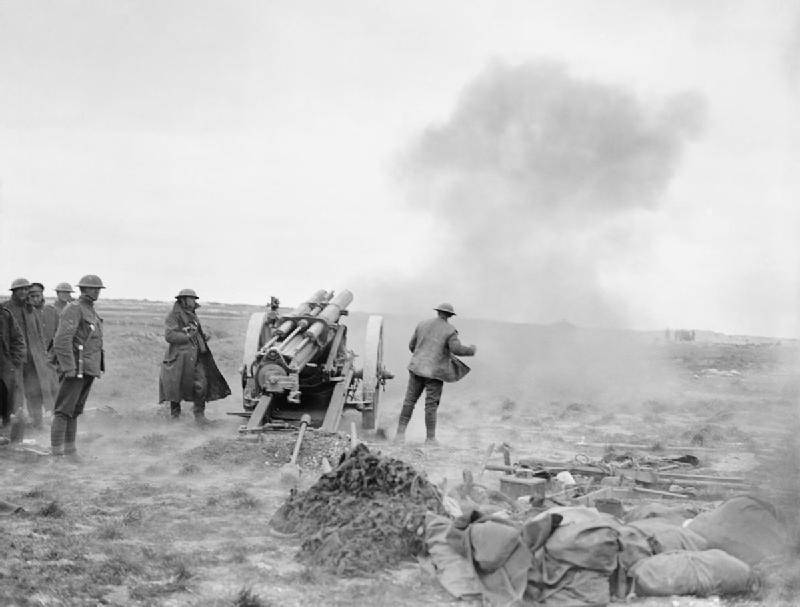
British 60-pound gun in positions
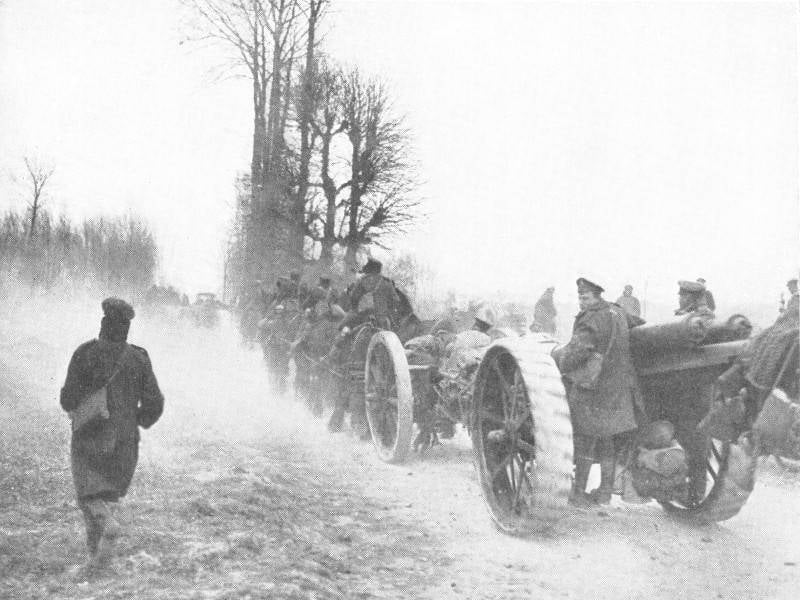
The retreat of the British troops. March 1918 of the year
Change plan offensive
The course of the battle violated the plans of the German command. Instead of the planned breakthrough of the front and coverage of the left flank of the British 17 and 2 armies, it turned out that the troops of the auxiliary 18 army had the greatest success. It was necessary to stop the offensive of the 18 Army and to achieve a result on the right flank (17 and 2 Army) or change the plan and shift the weight of the attack to the sector of the 18 Army, to the south-west direction. 23 March at a meeting in Aven with the participation of the emperor, it was decided to bypass both flank of the Allies. That is, to seek the simultaneous defeat of the British and French, throwing the British to the coast, and the French to Paris.
The 2 Army was ordered to advance not only north of the Somme, as was envisaged in the original plan, but also along its southern coast, in the direction of Amiens, with the aim of separating the 5 British and 6 French armies. The 18 Army was to advance in a southwesterly direction directly against the French Army 6, dropping its divisions first across the river. Oise, and then, in conjunction with the 7-th army, for p. Ena At the same time, the 17 Army was to advance in the direction of Abbeville, Saint-Paul, and in cooperation with the 6 and 4 armies, to drop the British into the sea. If the operation was successful, the German fleet was to thwart the evacuation of British troops from the continent.
Thus, now the German army launched an offensive in two directions. Instead of the previously planned offensive in one northwesterly direction, it was now envisaged to simultaneously conduct it in divergent directions. The German command overestimated the initial success, their strength and underestimated the capabilities of the enemy. The Germans believed that they had crushed the British army, which was a mistake. In addition, the French sent reinforcements and supplies to the dangerous direction faster and in larger volumes than the Germans.
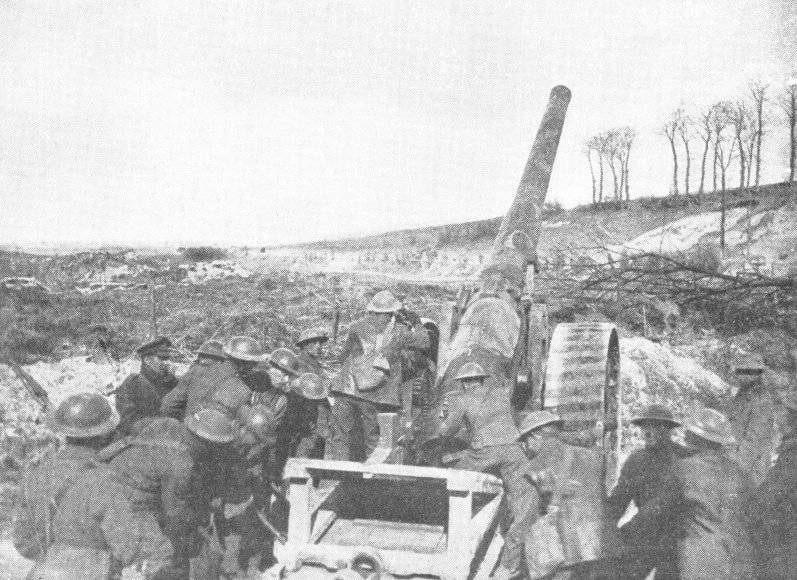
English 6 inch gun
Continuation of the battle
The Germans continued to advance. By the end of March 26, German troops reached the front of Div, Hersh, r. Somme, Albert, Miromon. The greatest success, as in the early days, was again in the band of the 18 Army. By the end of March 25, the exhausted 5-I British army retreated north-west to the sea, and the 6-I French army south-west to Paris. At the junction of the English and French fronts, another 24 March formed a gap up to 15 km wide, which opened the way to Amiens, before which only 35 km remained. It was at that moment that the German command clearly lacked cavalry divisions left in Russia. A powerful mobile connection could widen the gap, reach the operational space, smashing the enemy’s rear, creating chaos and intercepting communications.
In an effort to build on the success achieved, the German command increasingly shifted the center of gravity of the operation to the south-west. March 26 army command received new instructions. The 2 Army was ordered to advance south-west on both sides of the Somme and capture Amiens. 18-I army had to force the river. Avr and move further along the river. Oise in the direction of Compiegne, aiming at Paris. The mission of the 17 Army - the continuation of the offensive in the direction of Saint-Paul - remained the same.
Meanwhile, the Allies came to their senses and created a single command. 26 March in Dullan at a conference of government representatives and top military commanders of the Entente, French General Foch was tasked to coordinate the actions of the allied armies in France and Belgium. Foch immediately ordered the commander of the 5 th British, 1 th French armies and the commander of the reserve group Fayoule to concentrate all the available forces of Amiens, and the British divisions that had suffered heavy losses in the battles south of the Somme were replaced by French ones. The Allies took heart.
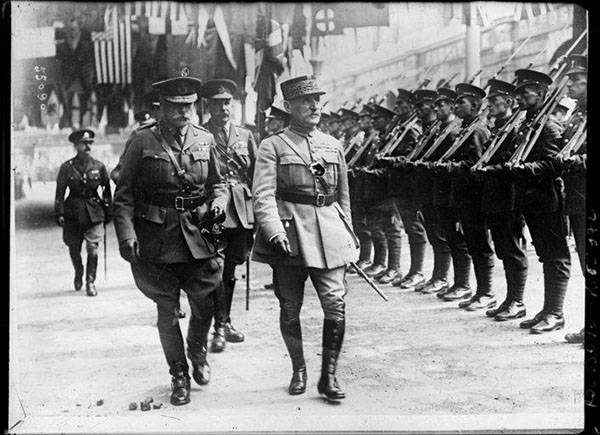
Ferdinand Foch
27 - March 28 all attempts of the 17 Army to break through to Arras were unsuccessful. Ludendorff was forced to stop the offensive north of the Somme and concentrate all his efforts in the south-west direction. March 27 The 18 Army advanced another 13-14 km and captured Mondidier, and the 2 Army captured Albert and the crossings across the river. Ankr and Miromon. 28 March 4-I, the British army moved another 8 - 9 km. However, this was the last day of serious success of the Germans. The British actively counterattacked. The large French reserves — the 1 and 3 armies — concentrated between the Lys and Oise rivers, with the task of blocking the enemy's way to Paris and covering Amiens. Allies gained superiority in forces. 28 March they managed to close the gap that formed earlier in the Amiens direction. Not having mobile troops, the German command could not build on the success and capture Amiens. The pace of the German offensive has decreased. Successes had a local character. The fighting was again depleted, which was beneficial to the allies. 5 April Ludendorff ordered to stop the offensive on all fronts. It was necessary to tighten the backward artillery, concentrate additional forces in order to deliver a new powerful blow.
Thus, the victory of the German army became "Pyrrhic." The historian Zayonchkovsky wrote: "The Germans did not know about the size of their success, did not have cavalry, their infantry was tired, the artillery was late, the supply was upset, and therefore could not use it." Ludendorff was forced to admit: “The enemy resistance turned out to be above the level of our forces. The transition to a battle of attrition was unacceptable, for such a thing contradicted our strategic and tactical position. ”
In addition, the moral decay of the German army, exhausted and tired of war, had already begun to be said. Exhausted German soldiers, breaking through the front of the enemy, capturing the zone of enemy warehouses, began to engage in robbery, gluttony and drunkenness, to the detriment of the development of the offensive. The situation with the supply of food and basic necessities by this time in Germany was almost catastrophic. The soldiers, having seized upon the place not ravaged by the war, tried to reward themselves (the good could be sent to their relatives), and took everything they could carry, the rest was destroyed.
Results of the first stage of the "spring offensive"
German troops achieved significant results. Attacking at the front in 70 km, they penetrated into the enemy defenses at 60 km and reached the line Bailleil, Albert, Willer-Bretonne, Hryvnia, Noyon, r. Oise. The most successful were the actions of the 18 Army. Its central corps for the 16 days of fighting passed 84 km. The average daily rate of attack was about 6 km. For the Western Front compared with the exhaustion fights in 1915 - 1917. it was a serious success achieved thanks to the good preparation of troops for the offensive, the creation of superiority of forces and means, the suddenness of the strike, the skillful organization of interaction between infantry, artillery and aircraft.
The battle involved 90 Germanic, 46 British and 40 French divisions. The total losses of the allies in the operation amounted to 212 thousand people killed, wounded and captured (according to other sources, more than 250 thousand people). German troops lost 240 thousand people.
However, the main task of the operation - to break through the front of the allies, to separate the British from the French and to smash them in a decisive maneuver battle (“throwing into the sea”) was not achieved. In the Anglo-French front, an arc-shaped protrusion was formed with a depth of 60 km and a length of front in 150 km. The extended front line demanded new forces and means for its retention. Thus, during the 1917 campaign of the year, the German army made an organized withdrawal in order to reduce the front and consolidate the defensive orders. The possibilities of the German army, which suffered great losses, were very limited. The allies could replenish their divisions and soon the fresh American army was to join the battle. That is, the seizure of the territory, without a decisive defeat of the enemy and the destruction of his manpower, only worsened the position of the German army.
At the most decisive moment of the battle during the formation of the breach of Amiens, the Germans were not able to quickly take advantage of this gap in the front line, since their cavalry was on the Eastern Front. The Allies could quickly transfer reserves from other sectors of the front, where it was calm. The actions of the Allies after the creation of a single command of the armed forces of the Entente on the Western Front became especially energetic. The French closed the gap and replaced the bloodless British divisions, but the Germans did not have a strategic reserve to immediately throw him into battle and develop the first success.
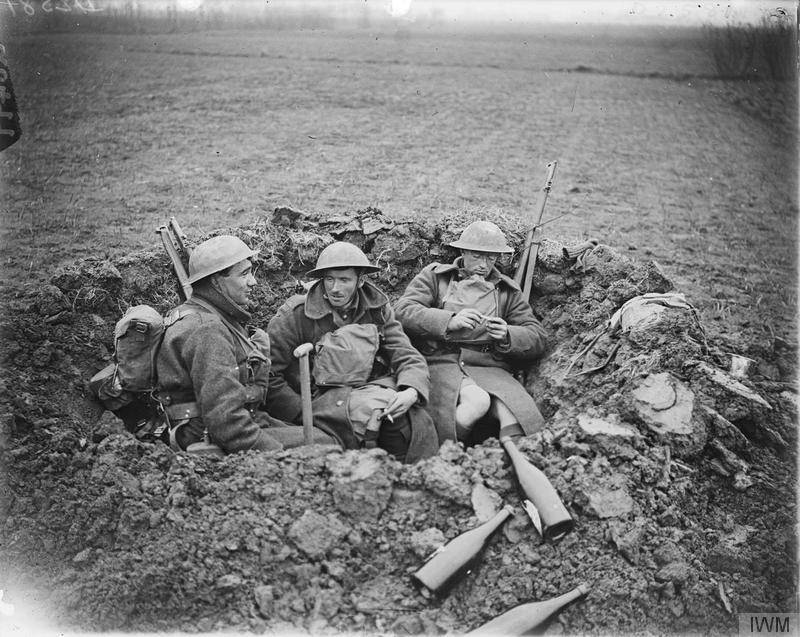
Sources:
Verzhkhovsky D.V. World War I 1914-1918 - M .: Military Publishing, 1954. // http://militera.lib.ru/h/verzhhovsky_dv01/index.html.
Zayonchkovsky A.M. The First World War. - SPb .: Polygon, 2000.
History World War I 1914-1918 Ed. I.I. Rostunova - M .: Science, 1975.
Liddell Hart B. Truth about the First World War. - M .: Eksmo, 2009.
Ludendorff E. My memories of the war 1914-1918. Translation from German by A. A. Svechin. Moscow: Veche Publishing House, 2014.
Petrosyan Yu. A. Ottoman Empire. - M .: Algorithm, 2013.
Shambarov V. The Last Battle of the Emperors. The parallel history of the First World War. - M .: Algorithm, 2013.
Shimov Ya. Austro-Hungarian Empire. - M .: Algorithm, 2014.
Shirokorad A. B. Germany. Opposition through the ages. - M .: Veche, 2008.
- Alexander Samsonov
- 1918 Campaign
US world domination strategy
Turkish invasion of Transcaucasia. “Thousands of Russians were shot and burned alive. Armenians are subjected to indescribable torture”
Romanian invasion of Bessarabia
How Romanian executioners exterminated Russian soldiers
German "fist strike" for the purpose of occupation of the western part of Russia
How the Germans occupied the western part of Russia
100 years "lousy" Brest world
100 years of the Baltic Fleet Ice Campaign
Spring Offensive of the German Army
"We will break the gap, the rest will be by itself"
Information